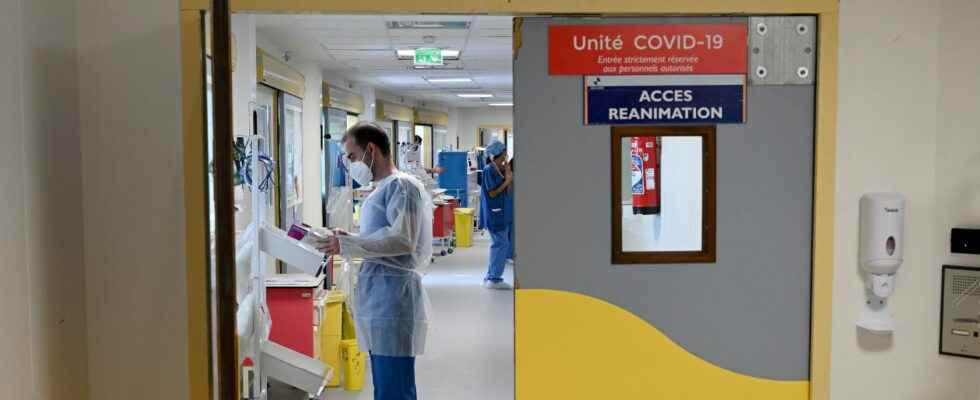Will the health indicators turn red again? On March 21, France had 11,519 new confirmed cases, an increase of 15.9% in seven days. Unsurprisingly, the incidence rate has also swelled, since it passed above the 50 mark to reach 69.2 contaminations per 100,000 inhabitants on March 18, in other words a rise of 26% in one week. At the beginning of March, it was still at 38. Ditto for the positivity rate which swelled by 31.1% in seven days, to climb to 13.3%, according to Public health France. “We have observed a fairly regular increase in the number of cases for a fortnight. It must be said that we are starting from very low, even if this figure is probably underestimated”, explains to The Express Yannick Simonin, virologist and research professor at the University of Montpellier.
For now, the impact at the hospital remains limited. According to CovidTracker, the number of occupied beds for Covid-19 is 13,334, which marks a slight increase compared to previous weeks. Daily hospital admissions follow the same line: they are calculated at 384.6 on March 21, against 283 on February 27. What about daily critical care admissions for Covid-19? As of March 21, there are 38, up (+ 43%) compared to last week. “This figure remains low, but it tends to increase. It reminds us that the Covid-19 is still present and that it is still circulating”, comments Yannick Simonin.
In addition, there are on average 25 hospital deaths for Covid-19 each day, up (+ 23%) compared to last week. Note that “all these patients did not necessarily die of Covid-19, but they were carriers during their stay”, summarizes the Department of Research, Studies, Evaluation and Statistics (Drees) . The process is as follows: each patient is supposed to be tested when they enter the hospital. If he dies, he therefore integrates the list of deaths “with” Covid which are not necessarily due to Covid. Indeed, a certain number of patients can die of another pathology.
Bas-Rhin, department where the incidence rate is the highest
As always, the virus is circulating heterogeneously in the country. In total, seven regions have an incidence rate above 50, the alert threshold. In detail, the northern part of the country seems more affected by Covid-19: Ile-de-France, Normandy, Hauts-de-France, Grand Est, Centre, Bourgogne-Franche-Comté, Provence-Alpes-Côte-d ‘Azure. The department where the incidence rate is the highest is Bas-Rhin with 160. Occitanie is the region least affected by the resumption of the number of cases, with 36 cases per 100,000 inhabitants.
To view the graph, click here.
It should be noted that the number of daily tests remains stable, which also explains the increase in the positivity rate. This means that by tracking as much, more is found. The number of tests (PCR and antigenic) carried out each day is stabilizing a little above 50,000, its lowest level since the start of the pandemic. In question: greatly reduced screening rules on February 1 (with the end of the theoretical obligation for contact cases). At the same time, the barrier gestures marked by the wearing of a mask or the respect of a distance have gradually disappeared from the daily life of the French. “They are just a distant memory. We also talk less about Covid-19, so people pay less attention,” said Yannick Simonin.
In addition to the lifting of barrier gestures, the Omicron XBB 1.5 sub-variant also pulls the epidemic upwards. “We know that it has a higher contagiousness”, completes the virologist. Indeed, this recombinant of two variants would be more effective in binding to the ACE2 receptor of human cells, which act as an entry point for the virus. For what ? “XBB 1.5 comes from XBB, which is a recombinant of two variants. It has a mutation, S486P, which gives it a transmission advantage”, explained to The Express Hervé Fleury, virologist and professor emeritus at the CNRS and the University of Bordeaux. If the Omicron sub-variant has been on French territory for several months, it begins to take over. “Half of the isolates are due to this XBB sub-variant”, underlines Yves Buisson, specifying that the Omicron system has “marked a turning point in the pandemic”.
“A controlled situation”
“We are in a controlled situation, we are not in a wave pattern as we have known previously. We must expect to see further increases in the number of cases and hospitalizations. In parallel, the immunity of the population is dulled, the most fragile people must think about doing their vaccination reminders”, continues Yannick Simonin. The increase in the number of contaminations can serve as booster shots for the most vulnerable who are not up to date with their vaccination.
This resumption of the epidemic in certain regions of France comes as international institutions prepare to lower their guard. The WHO indicated on Friday that it hoped to lower its level ofmaximum alert on Covid-19, believing that the epidemic was on the verge of becoming only a threat similar to the seasonal flu. “In France, we are going to witness ripples limited by collective immunity, but it is the end of the pandemic phase”, concludes Yves Buisson.
